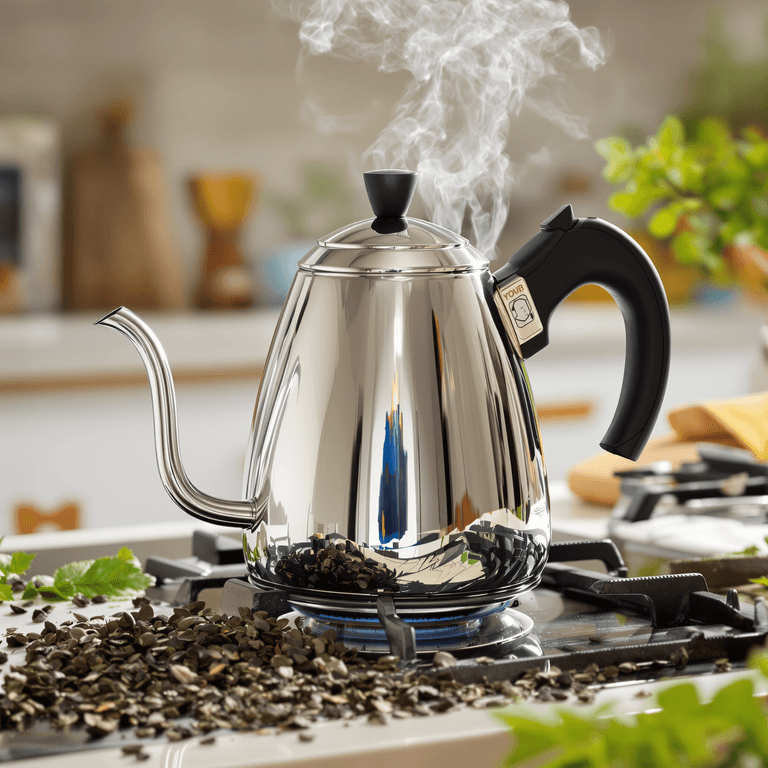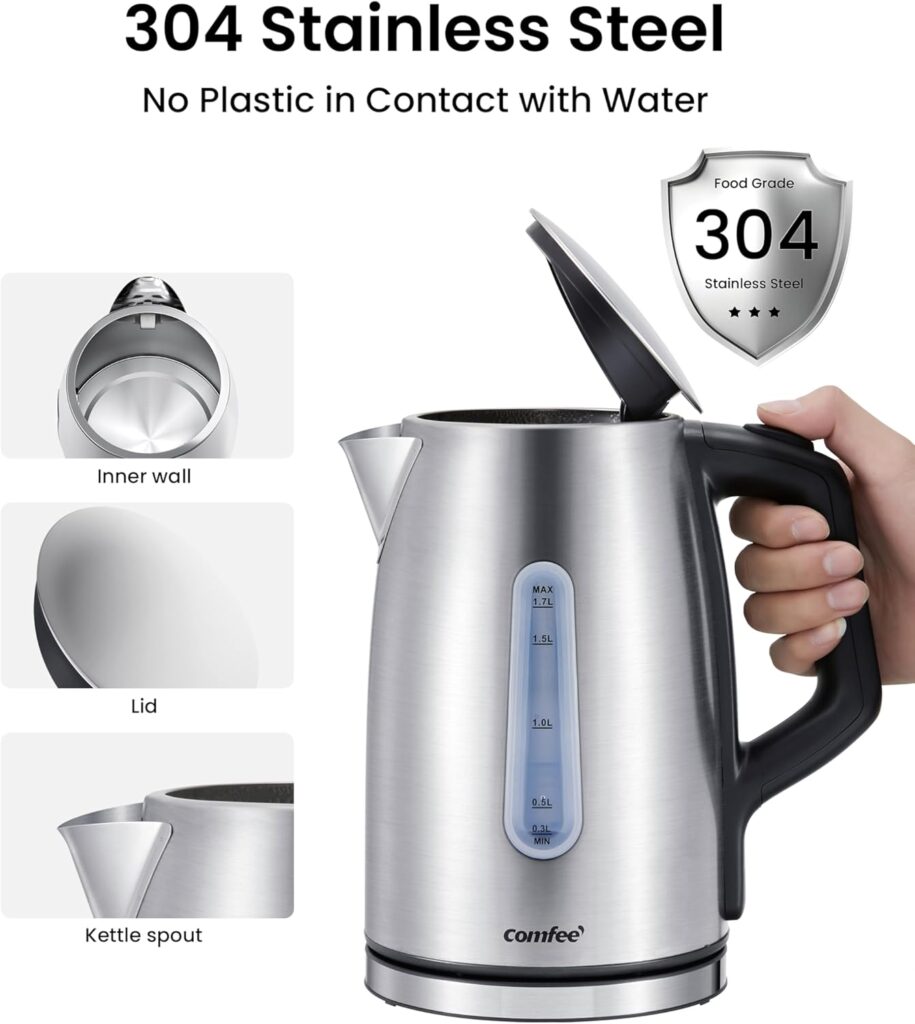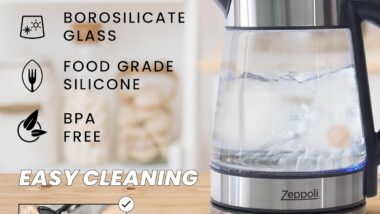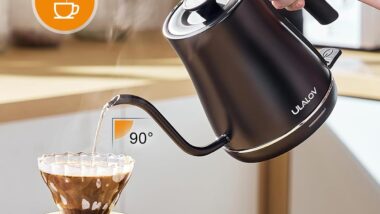How Do You Clean a Stainless Steel Tea Kettle
Taking care of your stainless steel tea kettle is essential to keep it looking great and working well. When your kettle is well-maintained, it not only adds beauty to your kitchen but also ensures that every cup of tea you make is pure and enjoyable.
Regular cleaning helps with three common problems:
- Mineral deposits that affect the taste of water
- Hard water stains making the kettle lose its shine
- Limescale buildup reducing heating efficiency
Keeping your kettle clean means better-tasting drinks, a shiny appearance, and a longer lifespan. You’ll also notice improved heating performance and energy efficiency when there’s no buildup in your kettle. In this article, we’ll go through the important steps to keep your stainless steel tea kettle in excellent condition, including daily maintenance and deep cleaning methods.
Understanding Stainless Steel Tea Kettles
Stainless steel is the best choice for tea kettles because it is extremely durable and resistant to rust. This strong material contains chromium and nickel, which form a protective layer that prevents corrosion and keeps the kettle looking new.
While there are other materials like borosilicate glass or copper, stainless steel stands out for several reasons.
Key Benefits of Stainless Steel Tea Kettles:
- Non-porous surface resists bacteria growth
- Heat-resistant properties prevent warping
- Naturally resistant to scratches and dents
- Non-reactive material preserves tea flavor
- Highly resistant to rust and corrosion
The smooth, non-porous surface of stainless steel makes it easy to clean. It doesn’t trap bacteria or absorb smells, so you can simply use basic cleaning products to maintain it. Additionally, the material’s ability to withstand high temperatures means you can safely use different cleaning methods without harming the kettle’s structure.
Routine Cleaning of Stainless Steel Tea Kettles
Your daily kettle cleaning routine doesn’t need to be complicated. Here’s a quick yet effective method to keep your kettle pristine:
- Fill the sink with warm water and add a few drops of gentle dish soap
- Wipe the exterior with a soft microfiber cloth dipped in the soapy solution
- Clean the interior by swishing the soapy water around
- Rinse thoroughly with clean water until no soap residue remains
- Dry immediately with a lint-free cloth to prevent water spots
Never put your kettle in the dishwasher – the harsh detergents and high temperatures can damage the finish, leaving your kettle looking dull and potentially compromising its durability. Hand washing preserves the kettle’s natural shine and protective layer.
Pro tip: Keep a dedicated soft cloth near your kettle for quick wipe-downs after each use to maintain its gleaming appearance.
How to Descale a Stainless Steel Tea Kettle

Hard water leaves behind mineral deposits, creating a chalky white buildup called limescale inside your kettle. This buildup affects your tea’s taste and reduces your kettle’s efficiency.
Here’s a proven method to remove limescale:
1. Create the Cleaning Solution
- Fill your kettle halfway with equal parts white vinegar and water
- For heavy buildup, use pure white vinegar
2. Descaling Process
- Bring the solution to a boil
- Turn off the heat
- Let it sit for 20 minutes
- Pour out the solution
- Rinse thoroughly with fresh water
3. For Stubborn Deposits
- Repeat the process if needed
- Use a soft-bristled brush to gently scrub remaining deposits
- Avoid metal scrapers or abrasive tools
Pro Tip: Regular descaling prevents heavy buildup and extends your kettle’s lifespan. A monthly descaling routine works best for areas with hard water.
Removing Stubborn Stains from Stainless Steel Kettles
Stubborn stains on your stainless steel kettle need a gentle yet effective cleaning solution. Create a simple paste by mixing:
- 2 tablespoons baking soda
- 1 tablespoon water
Apply this paste directly to the stained areas using a soft cloth. The mild abrasive properties of baking soda work to lift tough stains without scratching your kettle’s surface.
Let the paste sit on the stains for 5-10 minutes. Gently rub in circular motions with a microfiber cloth or soft sponge. For particularly resistant stains, reapply the paste and repeat the process.
Rinse your kettle thoroughly with clean water and dry it with a lint-free cloth to prevent water spots. This method works particularly well on:
- Tea stains
- Coffee marks
- Hard water spots
- Fingerprints
- Food residue
To maintain your kettle’s pristine condition, it’s essential to understand how to preserve and clean stainless steel. Additionally, you may find useful insights in this guide on how to clean stainless steel pans, which can also be applied to other stainless steel items in your kitchen.
Polishing Your Stainless Steel Tea Kettle for Shine
Your stainless steel kettle deserves a brilliant shine. A simple olive oil polish restores its lustrous appearance and creates a protective barrier against fingerprints and water spots.
Step-by-Step Polishing Guide:
- Clean your kettle thoroughly with warm water
- Dry the surface completely with a microfiber cloth
- Apply a small amount of olive oil to a soft, lint-free cloth
- Buff the exterior in circular motions
- Use a clean cloth to remove excess oil
Pro Tips:
- Use food-grade mineral oil as an alternative to olive oil
- Polish in the direction of the steel grain for best results
- Apply light pressure to avoid leaving oily residue
- Repeat monthly to maintain the shine
Your kettle’s surface will resist smudges and maintain its gleaming appearance between deep cleanings with regular polishing.
Preventative Maintenance Tips for Longevity
Your stainless steel tea kettle needs consistent care to maintain its pristine condition. Here’s your essential maintenance checklist:
1. Immediate Drying After Use
- Wipe the exterior with a soft, lint-free cloth
- Pay special attention to crevices and handles
- Use a clean microfiber towel for a spot-free finish
2. Regular Inspection Schedule
- Check the interior weekly for mineral deposits
- Examine the spout for calcium buildup
- Look for water spots on the exterior surface
- Clean any discovered buildup immediately
3. Storage Best Practices
- Keep your kettle in a dry area
- Store with the lid slightly open to prevent moisture
- Place on a dedicated shelf away from other kitchen items
These simple habits protect your kettle’s surface and extend its lifespan, saving you time on deep cleaning sessions later.
What to Avoid When Cleaning Stainless Steel Tea Kettles
Harsh chemicals pose serious risks to your stainless steel tea kettle. Never use bleach or chlorine-based cleaners – these substances trigger chemical reactions that corrode the metal surface and create permanent damage.
Abrasive cleaning tools can scratch and mar your kettle’s pristine finish:
- Steel wool
- Metal scrubbers
- Scouring pads
- Rough brushes
These items leave micro-scratches that trap dirt and bacteria, making future cleaning more difficult. The scratches also create weak points where corrosion can begin.
Avoid these common damaging practices:
- Using undiluted cleaning products
- Scrubbing with excessive force
- Applying cleaners meant for other surfaces
- Leaving cleaning solutions to sit for extended periods
Stick to gentle cleaning methods using soft cloths and non-abrasive sponges to maintain your kettle’s protective finish and natural shine.
Additional Care Tips for Stainless Steel Tea Kettles with Glass Parts
Stainless steel kettles with glass components require specific care to maintain their durability and appearance. Here’s what you need to know:
Heat Safety Measures
- Always fill your kettle with water before heating
- Keep the water level between the minimum and maximum marks
- Switch off the kettle immediately if you notice it’s running dry
Cleaning Glass Components
- Let your kettle cool completely before cleaning
- Use a gentle 1:1 vinegar-water solution for glass parts
- Clean glass sections with a soft microfiber cloth to prevent scratches
- Avoid temperature shocks – don’t rinse hot glass with cold water
Daily Maintenance
- Store your kettle in a dry place when not in use
- Check glass seals regularly for signs of wear
- Remove limescale buildup promptly to prevent glass clouding
- Use filtered water to reduce mineral deposits on glass surfaces
Conclusion
A clean stainless steel tea kettle makes your tea time even more enjoyable. By regularly cleaning and deep cleaning your kettle, you can keep it looking and working great. Using dish soap for everyday cleaning and vinegar for descaling will give you long-lasting results.
Taking care of your kettle properly has many benefits:
- Better tasting tea
- Longer lasting kettle
- Attractive appearance
- Less mineral buildup
- Safe and healthy brewing
Feel proud of your shiny stainless steel tea kettle. Every time you clean it, you’re protecting your investment and ensuring many perfect cups of tea. Your well-maintained kettle is always ready to brew your next comforting cup with style and efficiency.

How Do You Clean a Stainless Steel Tea Kettle: FAQs
Why is it important to regularly clean a stainless steel tea kettle?
Regular cleaning of a stainless steel tea kettle helps maintain its appearance and functionality by preventing stains and mineral buildup, ensuring your kettle remains efficient and visually appealing.
What are the best routine cleaning methods for a stainless steel tea kettle?
For routine cleaning, use gentle dish soap and warm water to wash the kettle by hand. Avoid using a dishwasher as it can damage the kettle’s finish. Dry thoroughly after washing to prevent water spots.
How can I effectively descale my stainless steel tea kettle?
To remove limescale caused by hard water, fill the kettle with a solution of white vinegar and water. Let it sit to dissolve mineral deposits, then rinse thoroughly. This method restores the kettle’s interior cleanliness and performance.
What is the recommended way to remove stubborn stains from a stainless steel tea kettle?
Create a paste using baking soda and water, then gently apply it to the stained areas on the kettle’s surface. This natural abrasive helps lift stains without damaging the stainless steel finish.
How do I polish my stainless steel tea kettle to restore its shine?
Use a soft cloth lightly coated with olive oil to polish the kettle. This technique removes streaks and smudges while enhancing the kettle’s natural shine for an attractive appearance.
What cleaning practices should I avoid to protect my stainless steel tea kettle?
Avoid using harsh chemicals like bleach or chlorine-based cleaners as they can cause corrosion. Also, refrain from abrasive tools that may scratch or damage the kettle’s surface finish, preserving its longevity and look.


